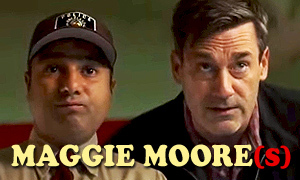Welcome to Marwen: History vs. Hollywood
| REEL FACE: | REAL FACE: |
Steve Carell
Born: August 16, 1962 Birthplace: Concord, Massachusetts, USA | Mark Hogancamp
Born: 1962 Birthplace: Newburgh, New York, USA |
Steve Carell as Hogie (Mark's Alter Ego in Movie)
| Hogie (Mark's Alter Ego)
|
Leslie Mann
Born: March 26, 1972 Birthplace: San Francisco, California, USA | Colleen Vargo
Renamed Nicol in the Movie |
Leslie Mann (as Nicol's Alter Ego in Movie)
| Colleen (Doll Alter Ego)
|
Did the men outside the bar beat Mark Hogancamp because he told them he was a cross-dresser?
Yes. The Welcome to Marwen true story confirms that on April 8, 2000, five men jumped then-38-year-old Mark Hogancamp outside of the Luny Tune Saloon in Kingston, New York, after he had informed one of them that he liked to dress in both men's and women's clothing. At home, he had a closet filled with over 200 pair of women's boots and pumps that he is thought to have worn to feel close to women. He was attracted to women but was sure they would reject him.
Following the attack depicted in the movie, Mark is found by a waitress named Wendy, with whom he is in love. In real life, Mark was found by a bartender named Nora Noonan, who helped get him to the hospital before he drowned in the blood that was filling his lungs.
Did Mark Hogancamp testify against the five men who nearly killed him?
Yes. A Welcome to Marwen fact-check reveals that Mark had to testify more than once. "I had to testify three times," he explained in the Welcome to Marwencol book. "Three times I had to see those guys. And one of them was looking at his nails in the courtroom like, 'Come on...this is a hassle.'" A woman who helped crime victims was in the courtroom and gave Mark a small teddy bear to hold under the witness stand so that he could channel his feelings into the bear instead of letting them show on his face.
Were the men who beat Mark Hogancamp neo-Nazis?
No. This is the movie's biggest fabrication with regard to the true story. In real life, Mark's assailants did admit to beating him because he told them he was a cross-dresser, which would make it a hate crime, but they weren't actually neo-Nazi white supremacists like in the movie. One of the real-life attackers, a 16-year-old nicknamed "Black Freddy," wasn't even white. However, to reinforce the point, the movie even shows one of the men with a swastika tattoo on his bicep. Both in the Marwencol documentary and in the articles written about Mark Hogancamp, including in The New York Times, there was never a mention of his assailants being neo-Nazis. They also appear a bit older in the film. In real life, two of the five attackers were still teenagers.
What were Mark Hogancamp's injuries?
Following the beating, Hogancamp was in a coma for nine days and spent 43 days recovering in the hospital. Doctors had to rebuild his face. He suffered brain damage and lost nearly all memory of his past, including his early marriage, time in the Navy, family, girlfriends, etc. Like in the movie, he had to learn how to eat, walk and write again. He was plagued by post-traumatic stress disorder, which the film focuses on as he attempts to find the strength to confront his attackers in court. Given that he was close to death and had his prior memories erased, Hogancamp considers everything after the attack to be part of his second life.
"When the teenagers kicked my head to pieces, they wiped, I mean, everything. All memory of everything," he explained in the documentary. "My memories that I do get, they come back in stills, just a single shot, but no context."
Did Mark leave the hospital because he had recovered?
No. The Welcome to Marwen true story reveals that he actually left the hospital because his Medicaid had run out. Once at home, he did receive cognitive, physical and occupational therapy, but his state-financed insurance stopped covering it in under a year. He never received psychiatric counseling to treat his PTSD, because there was no coverage for it. -Welcome to Marwencol Book
Did he lose his ability to draw?
Yes. This is in line with the Welcome to Marwen true story and is confirmed in Jeff Malmberg's Marwencol documentary. The attack left him with damage to the left side of his brain, which took away his ability to draw. Like in the film, photographing the figures in his 1:6 scale town of Marwencol allowed him to express himself as an artist.
"I've gotten over the anger," Mark said. "Wanting to go out and kill all men just because they took from me what I loved the most. That's why I created my own world where my people love me for who I am. I treat them with respect; I cover them up so that when I set them up they perform easily for me. They are my little actors and actresses." -The New York Times
Did Mark Hogancamp really work as an illustrator of World War II comics before the attack?
No. He did create plenty of WWII illustrations, but only as a passionate amateur. In the early 1990s, he had worked as a carpenter designing retail showrooms for a lighting company (The New York Times). After losing that job, he worked full time at the Anchorage restaurant.
Following the attack, he received disability checks and worked just 4-5 hours once a week at the Anchorage — cooking, cleaning, washing dishes and doing other things that owner Julie Swarthout requested. It had become too much for him if he was around a lot of people for too long. -Marwencol Documentary
Had Mark Hogancamp really struggled with alcoholism and homelessness prior to the attack?
Yes, but his extensive real-life battle with alcoholism is downplayed in the movie. The Welcome to Marwencol book reveals that his friend Tom found about 50 half-gallon liquor bottles scattered around his apartment. His addiction to alcohol had led to DUIs, jail time and even homelessness. After waking from his coma, he couldn't remember any of those experiences. He had lost his taste for alcohol. If it wasn't for journals and notebooks filled with diary entries and drawings that dated back to 1984, he would have no record of that part of his life. Studying the pages, he learned of his battle with alcohol, his arrest, his stays in rehab, and his bouts of homelessness.
Hogancamp began to ask others what he was like back then. “Was I a bad guy? Was I mean? Was I? And they would tell me, ‘No, you weren’t mean. You were just drunk.’” -Marwencol Documentary
Had Mark Hogancamp been in jail?
Yes. Among his old photos, he discovered a mugshot of himself (displayed below). In addition to being arrested for drunk driving, he was jailed for showing up drunk at a girlfriend's house with a 12-gauge shotgun he was using as a crutch. One of his 1995 diary sketches depicted him being sentenced to time in jail. -Welcome to Marwencol Book
Did the attack lead to the breakdown of Mark Hogancamp's marriage?
No. In researching the Welcome to Marwen true story, we learned that Hogancamp did have an ex-wife, but they got divorced long before the attack. She had left him because of his heavy drinking. He could not remember her after waking up from the coma. He learned that she was an attractive “Russian Polish” girl named Anastasia. They had gotten married on August 4, 1984. His only evidence of his marriage was through photographs and home movies he found, in addition to what family and friends had told him. -Marwencol Documentary
To feel the closeness of a woman again, his alter ego in his doll world, an Army doll named Hogie, carried on relationships with other female dolls and eventually got married to a doll named Anna Romanov, a Russian princess who had saved Hogie from the SS.
Was Mark's 1:6 scale town of Marwencol really filled with all women?
Yes. According to Mark's storylines, the SS had come through the town and killed all the men. The women of Marwencol helped to rescue a downed fighter pilot named “Hogie,” who represents Mark himself. Hogie opened a bar in the town and a catfight club next door called “The Ruined Stocking,” where Hogie would pay the women to put on staged catfights. Obvious themes emerged in his storylines that related to his own traumatic experience and its aftermath, namely male brutality, fear, rage and the comfort of a town with all women. One of the only rules of Marwencol was that everyone was to get along. This included Americans getting along with Germans, etc.
How did Mark Hogancamp's 1:6 scale WWII town of Marwencol get its name?
The name of Mark Hogancamp's 1:6 scale World War II-era Belgian town of "Marwencol", which he built along the side of his trailer home, is a combination of Mark's own name and the names of two women he had crushes on, Wendy and Colleen. Wendy was a married waitress at the Anchorage restaurant where he worked, and Colleen was an attractive blond neighbor who was also married. The town's name is shortened to "Marwen" for the movie since the film only includes one of the women by name, Wendy. Colleen is renamed Nicol in the movie and portrayed by Leslie Mann.
Did Mark Hogancamp really create the 1:6 scale town of Marwencol to help deal with his PTSD from the attack?
Yes. Mark created the town after his state-sponsored rehabilitative services ran out following the attack and he was unable to afford psychological therapy for PTSD. He populated his World War II-era fictional Belgian town with Barbie Dolls and WWII action figures that represented his friends, family, attackers and himself. His alter ego was a toy soldier named Captain Mark "Hogie" Hogancamp. The dolls engaged in epic battles with dramatic storylines, helping him to transform the trauma of a violent attack into a masterfully rendered alternate world filled with action, adventure, romance and drama.
When Mark felt angry in life, he often dealt with it by taking it out on the SS dolls in the town. “I could act out my revenge and anger and rage in photographs,” says Mark. He captured his scaled-down alternate reality of models and figures in strikingly realistic photographs, taking thousands with his Pentax camera and later a Canon digital camera. The storyline of Hogie, his doll alter ego, began to closely mimic his own story. Hogie was captured by an SS soldier, taken to town, and violently beaten by five SS men (pictured below). To deal with his PTSD from the attack, Hogie the doll creates his own miniature town of smaller dolls and pulls a little toy Army jeep behind him, just like Mark did in real life.
"I still really miss somebody to talk to about still the way I feel," Mark commented in the documentary. "My mind can’t decide what world to go for. Realistic world? But there are dangers out there. People out there are so real. And I don’t understand all that. I feel safe when I get in my town, and it just takes everything away. I prefer to live in my world. I want to live here in Marwencol."
Did the real Nicol have an abusive boyfriend?
No. Leslie Mann's character Nicol, who's real-life name is Colleen, did not have an abusive boyfriend. According to the documentary, she was married with three children.
Did Mark really pull his toy Army jeep behind him when he left the house?
Yes. When he walked into town, he would drag his Army jeep behind him, filling it with some of the dolls from Marwencol. They were there to protect him and help him stay calm. “I’m always on guard, always looking over my shoulder, always worried about being attacked again,” said Mark. Another benefit to bringing the model jeep was to wear down its rubber tires to get rid of the factory seams and make it appear more authentic. Like in the film, Mark was a stickler for detail. -Marwencol Documentary
How did the story of Mark Hogancamp's WWII doll town make it to the big screen?
The path from Hogancamp's yard to the big screen started with his neighbor, magazine photographer David Naugle (not in the movie), who became curious after he saw Hogancamp walking along the road dragging an Army jeep behind him filled with dolls. After passing Hogancamp several more times, he eventually decided to pull over and inquire. It wasn't long before an envelope stuffed with Hogancamp's photos showed up in his mailbox. The images captured stories of fear, violence, trust, love and friendship. Amazed by Hogancamp's work, Naugle sent the pictures to Esopus, an art journal that eventually featured Hogancamp's photos and story. His 1:6 scale World War II town of Marwencol grew in popularity, with the photos appearing in other art publications and at New York City's White Columns art gallery in Greenwich Village.
Documentary filmmaker Jeff Malmberg happened to subscribe to Esopus and noticed Hogancamp's story. He decided to turn it into the subject of his debut film, 2010's Marwencol, which had taken the director/editor more than four years to finish. The documentary received critical acclaim, capturing the attention of Hollywood. It became the inspiration for the 2018 Robert Zemeckis movie Welcome to Marwen. Hogancamp's life story and refined re-creations of his work appear in the acclaimed 2015 art book Welcome to Marwencol.
Is the clerk in the hobby store based on a real person?
No. The hobby store clerk, Roberta (played by Merrit Wever), is fictional. So is the notion that her sending Mark Hogancamp's photos to a friend who owns a gallery is how Mark's work was discovered. As stated in the previous question, it was actually magazine photographer David Naugle who played the biggest role in Mark's work making it out into the world. As for the hobby store, Mark did have friends there, but it was the owners, Janet and Mark Wikane, not a clerk at the store.
What types of dolls did Mark Hogancamp fill his town of Marwencol with?
After he moved into a trailer home in rural Kingston, NY, he rediscovered his passion for World War II miniatures. However, he was no longer able to manipulate the small 1:36 scale figures he had been used to. Instead, Janet and Mark Wikane, the owners of J&J's Hobbies, recommended that he work with 1:6 scale. This is the size of 12-inch-tall figures, including Barbies. He also worked with action figures by Dragon Models Limited, Blue Box International, and Ultimate Soldier. -Collectors Weekly
What else does the film leave out?
As we explored the Welcome to Marwen true story, we discovered that the most important thing that the movie leaves out is Mark Hogancamp's relationship with his mother, who passed away not long before the movie's release. In reality, when Mark left the hospital he did not move into a quaint rural house, as seen in the film. He went back to his apartment and lived with a friend and former coworker named Tom (omitted from the movie), who became his caregiver. When Tom had to relocate for work, Mark's mother, Edda, moved him into a trailer home. He even had a doll for her in his town of Marwencol. His mother was represented by a Pussy Galore doll based on the character from the James Bond movie Goldfinger. The attack and her son's subsequent retreat into a world of dolls was painful for her. However, she did buy Mark a Canon digital camera when his old Pentax broke, which helped him immensely.
How do Mark's dolls differ in the movie compared to real life?
The movie allows marks imagination to come to life, creating CGI versions of his dolls. More specifically, the film uses motion-capture animation, which is achieved by dressing the actors in skin-tight suits and tracking their movements. Obviously, Mark's real-life dolls were restricted to the confines of his imagination.
Were Mark Hogancamp's attackers punished?
All five of the men who nearly killed Mark were convicted of their crime, but only three served time in jail. The other two were put on probation. -The New York Times







